Max Ernst at Transamerica Pyramid Center
Entrance at Transamerica Redwood Park
535 Washington Street, San Francisco
Gallery Wendi Norris, in partnership with SHVO, is proud to present a suite of twelve sculptures by the influential 20th-century artist Max Ernst (Brühl, Germany, 1891 — Paris, France, 1976) in San Francisco’s iconic Transamerica Pyramid Center’s Redwood Park. This exhibition extends SHVO’s initiative to curate world-class cultural programming in landmark properties, and Gallery Wendi Norris’ history of staging major exhibitions in non-traditional venues.
The sculptures—which have never previously been publicly exhibited together—are bronze casts of three-dimensional works executed by Ernst between 1938 and 1939, alongside his romantic partner, the celebrated artist Leonora Carrington. One of the foremost pioneers of the Surrealist and Dada movements, Ernst moved with Carrington to a house in the idyllic village of Saint-Martin-d’Ardèche in the south of France in 1938 to escape the pre-war conditions in Paris.
The period during which they inhabited their house between 1938 and 1941 was of consequential importance to the artistic trajectories and livelihoods of Ernst and Carrington. Nowhere is this more apparent than in this complex three-dimensional series of sculptures that transformed their house into a total work of art, epitomizing both artists’ daring and experimental visions that continue to provoke and inspire audiences to this day. These works stand as enduring relics of this key era of Ernst’s practice and life, exemplifying the provocative, witty and defiant spirit that cemented him as a towering force of the Surrealist movement, and one of the most significant figures in 20th-century art.
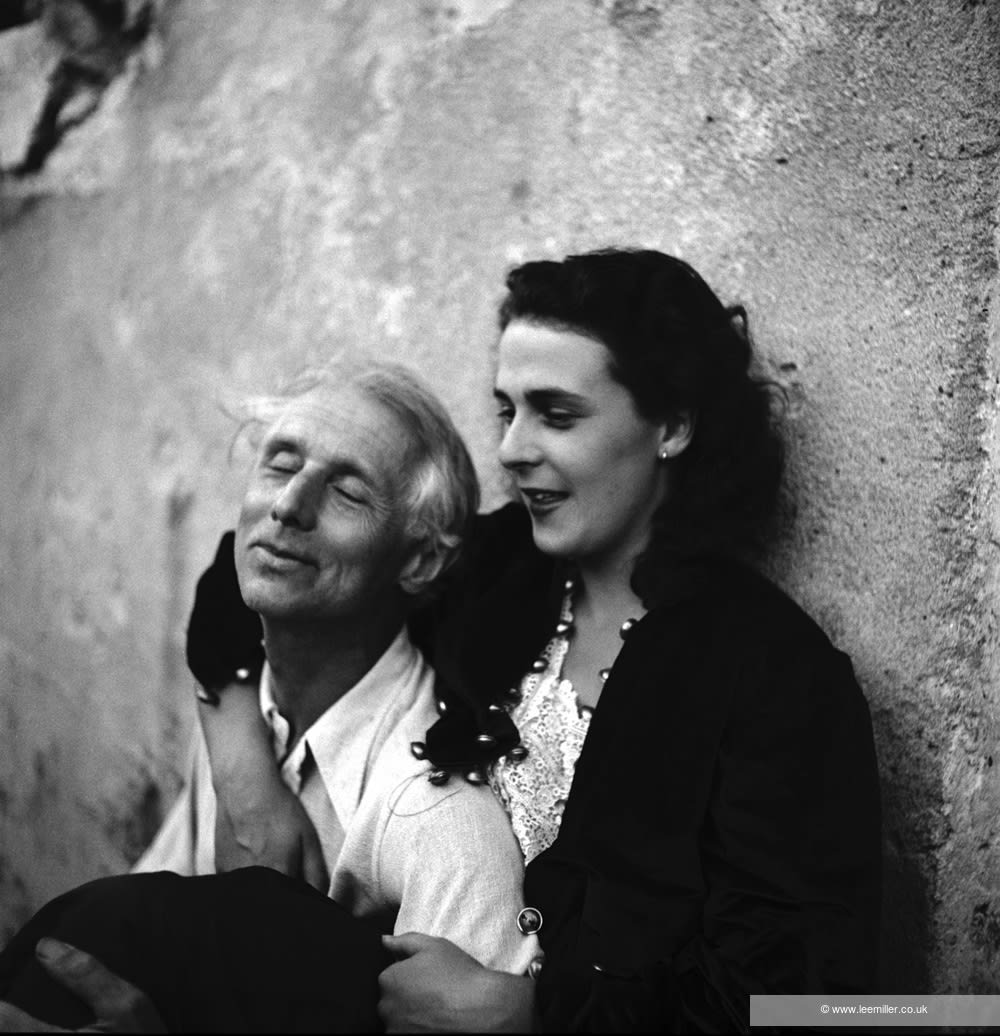
Max Ernst and Leonora Carrington, Saint-Martin-d’Ardeche, France, 1939 by Lee Miller. © Lee Miller Archives, England 2025. All rights reserved. www.leemiller.co.uk
a surrealist legacy in Saint-martin-d'ardèche
Introduction and context: an intimate utopia interrupted by war
In 1938, Max Ernst and Leonora Carrington—who began their relationship in the year prior—moved to Saint-Martin-d'Ardèche, a small village in the south of France, out of concern for the pre-war political situation in Paris. In that rural town where the Ardèche River unfolds through a spectacular gorge before converging with the Rhône, the couple bought a 17th-century house in a vineyard-laden area known as Les Alliberts. Although brief, the period during which they inhabited this house (intermittently between 1938 and 1941) was extraordinarily influential to the artistic trajectories of Ernst and Carrington. The intimate dialogue and projects undertaken by the artist-couple at Saint-Martin-d'Ardèche are the elaboration of a sort of Gesamtkunstwerk (a "total work of art") for which the house is the repository.
Ernst, in those years, painted some of his most influential canvases and created collages to illustrate Carrington's texts, but, above all, the house gave him the opportunity to return to a subject that, in his work, is a late discovery and an intermittent practice: sculpture. While Carrington used doors, windows, and furniture inside the house to present her early hybrid characters, Ernst devised a complex three-dimensional iconographic program for the exterior and access points of the house.
For many scholars, this picto-sculptural group is an evolution of some of the themes and interests that appear in Ernst’s collage-novel Une semaine de bonté (1934). In this sense, the house can be considered a monumental three-dimensional collage wherein a confusion of identity, erotic tension, gender fluidity, and human-animal hybridization takes center stage and re-signify forevermore the house itself and the subsequent work of its maker.
Between 1938 and 1939, the house became a meeting place for personalities linked to Surrealist circles. This was a critical moment for the movement since Ernst had formally abandoned it in refusal of André Breton's dogmatic guidelines against his close friend, the poet Paul Éluard. In 1939, Éluard and his wife Nusch, Leonor Fini, Man Ray, Ady Fidelin, Roland Penrose, and Lee Miller, among others, visited the house.
After the declaration of war on September 3, the Arcadian atmosphere darkened. In that same month, Ernst was arrested as an alien enemy and sent first to Largentière prison and shortly after to Camp de Milles, an internment camp near Aix-en-Provence. Although Ernst was allowed to return home at the end of 1939, to Carrington’s despair, he would be arrested again in May 1940. Shortly afterwards, Carrington fled to Spain with the intention of crossing the Atlantic, which happened only after facing a mental breakdown and confinement in an institution in Santander. Ernst was freed soon after and hastily returned to Les Alliberts to collect the few rolled paintings and belongings he could carry with him on his way to exile in America. This flight had forced Carrington to sell the property in a hurry, leaving behind an extraordinary group of sitespecific works exposed to the elements, artworks that represent the last breath of the avant-garde before its relocation to the other side of the ocean.
No subsequent visit by Carrington to the site is documented. Ernst, on the other hand, after moving back to France from the US in 1952, returned to Saint-Martin-d'Ardèche for a short visit in October 1966, with the intention of making casts of some of the sculptures he had not seen for the past 25 years. Made mostly of cement and found metal objects, they were losing their integrity through time and exposure to the elements, despite the efforts of successive owners to preserve them. Though the property was deemed a historic house (“Maison Historique”) by the French Ministry of Culture in 1992, all the necessary steps to ensure its full protection had not been taken. Today, the house still stands, but is not open to the public. Some of the works created in 1938 – 1939, especially those outdoors, have disappeared with the passage of time; some of them exist only in these bronzes.
After Ernst's death in 1976, with permission from his family and widow, Dorothea Tanning, a series of bronze casts were made from plaster models by two foundries in Paris, Susse Frères and Godard. An edition of 12 was casted, numbered 1 through 8, with 4 proofs. A number of them were presented at Galerie Gabus in Geneva (1991) and at Galerie Eric Touchaleaume in Paris (1992). Although the sculpture group has fallen into relative oblivion since then, its legend has grown through new readings and interest in Ernst and his life with Carrington. The working plasters were destroyed in 2015.
Of the places inhabited and decorated by Ernst, the Saint-Martin-d'Ardèche house is the one that best evokes its original spirit. According to renowned art historian Werner Spies, of all those houses and studios, from Cologne to Huismes, "only a visit to Saint-Martin d'Ardèche can still give a vague idea of the atmosphere that Max Ernst had imagined.” As indexes of site-specific works created by Ernst in the months leading up to World War II, these bronzes are a fitting yet fragmentary testimony of an unprecedented Ernstian experiment.
A place documented at its time
Due to the potential oblivion facing the house and their transcendental role in Ernst’s career, the sculptures and sculpture-paintings of Saint-Martin-d'Ardèche were well-documented at the time of their creation. The importance of this decorative program within Ernst's oeuvre was evident to all visitors to the house. Lee Miller extensively photographed all the details of the site. A selection of these images, along with others taken by her husband, Roland Penrose, were published in the June 1940 issue of The London Bulletin, the magazine directed by E.L.T. Mesens that represented The Surrealist Group of England.
Less than a year before, a larger selection of these photographs were featured in Cahiers d'Art with the prologue-poem “Max Ernst” written by Georges Hugnet only four days before the declaration of war in France. The poet plunges into a universe of hybrid creatures to speak of both Ernst and Carrington through animal and landscape metaphors. The publication in Cahiers d'Art is of importance as the issue was published in the autumn of 1939, while Ernst was imprisoned as an enemy of France due to his German citizenship. In Éluard's letter to the French authorities requesting the release of his friend, the poet refers to the house, describes it briefly and invites the addressee to behold the quality of the works in the magazine, as proof of Ernst's roots in France and his commitment to the country.
Today, photographs by the French Ministry of Culture show the current state of the building and the remaining sculptural decorations. They can be consulted through this link here.
Protecting and signifying a house and its inhabitants: a complex iconographic program
Along with those by Miller and Penrose, other photographs show the coexistence between the artists who lived in the house and these sculptures. Two images provide very relevant information: in one, Carrington poses next to a standing mermaid statue; in the other, Ernst is seated on the wall that supports the mermaid while leaning on her shoulder, occupying the place that will soon be that of a powerful sphinx. These images are the best examples of the self-referential character of the picto-sculptural ensemble devised by Ernst.
Just as Carrington constantly portrayed herself at this time, both in her paintings and in her writing, Ernst demonstrates a similar need to represent himself. In his sculptural decorations for Saint-Martin-d'Ardèche, Ernst references his own creations which turns the house into a formidable crossroads in an artistic trajectory within which sculpture still occupied a controversial place. For Ernst, sculpture has its best expression in his experiences with concrete places rather than with general notions of the practice or with isolated processes performed in the studio. The words of Werner Spies seem to reflect this idea: “on each occasion it is the genius of the place that inspires his work.”
To better understand these bronze casts, this essay analyzes them “in order of appearance” within the scenography orchestrated by Ernst from the exterior to the interior of the house.
On the front façade, Ernst devised a great scene that serves as the curtain of an intimate domestic theater. The scene is formed by a group of three monumental characters in relief. The first is a naked woman holding in her hand the head of a lion, an allusion to Oedipus and the sphinx. Central to Ernst's iconography dating back to the painting Oedipus Rex (1922), the myth in this case features a reversal of roles: Oedipus is portrayed as a woman, with her hand outstretched in a questioning gesture (a reference to Ingres' version of the myth), while the sphinx has been reduced to a lion head, taken directly from the character “Le lion de Belfort” from Ernst’s collage-novel Une semaine de bonté (1934). Ernst’s depiction of a tragedy driven by the rejection of one’s father and one’s roots is possibly a coded message about Carrington and her escape from her family in England.
The interpretation of the female figure as Leonora is supported by the fact that her companion, on the left, is a large bust of the anthropomorphic bird Loplop, Ernst's alter ego. Its body is formed by a sloping pilaster that supports the house and shelters another hybrid figure: a small bipedal being, an angel or winged genius that spreads its wings to the rhythm in which its legs move. Between this pair there is also an exchange of identities: Loplop has a bird’s face and human arms, while the angel has a semi-human body and face, but its arms are wings with thick plumage. The bronzes created from this set are reproduced in the head of Loplop (Tête de Loplop) and the figure of Loplop ailé. In the original work in cement, the angel has lost a key element, which is preserved in the bronze: the flora covering its sex to signify either its androgyny or its asexual nature (angels’ bodies are created with no sex according to Catholic theology).

Max Ernst, "Loplop ailé," cast in 1991. Bronze, 91 3/4 x 41 3/4 inches. © 2025 Artists Rights Society (ARS), New York / ADAGP, Paris. Photography by Glen Cheriton.

Max Ernst, “Tête de Loplop,” cast in 1991. Bronze, 31 1/4 x 16.9 x 9 1/2 inches. © 2025 Artists Rights Society (ARS), New York / ADAGP, Paris. Photography by Glen Cheriton.
The fluttering movement of "Loplop ailé" is somewhat agitated, as if to scare away anyone approaching the house, thereby accentuating its apotropaic function. A subversion of the concept of a scarecrow, this angel figure is not a man scaring away birds, but a bird scaring away people: a scarehumans. It seems to have fulfilled this role if we believe the stories about the discomfort that these figures provoked in the neighbors back in 1939. The gesture of its wings, as if in a spinning motion, is repeated in the minotaur of one of the sculptural frescoes in the loggia that opens access to the house. Within Ernst’s output, this sculpted hybrid figure with restless arms bears resemblance to the central figure of Le triomphe du Surréalisme (1937) and to the enigmatic character of a pictorial masterpiece, painted, in fact, in Saint-Martin-d'Ardèche: Swampangel (1940).
The next sculptural group before crossing the threshold of the house, which stood on the wall that enclosed the side garden, is Sphinx et Sirène or Minotaure et Sirène, whose originals have disappeared. To this same group belongs a detail that was detached from the whole to create an independent piece: Tête de Sphinx or Tête du Minotaure. Although it is plausible that the figure accompanying the mermaid is a minotaur, its reading as a sphinx is more in line with the oedipal substratum that runs through the iconographic program of the house. This creature also reveals the influence of Leonor Fini, an artist for whom the sphinx was a personal banner of ambiguous femininity and the enigmatic powers of androgyny.
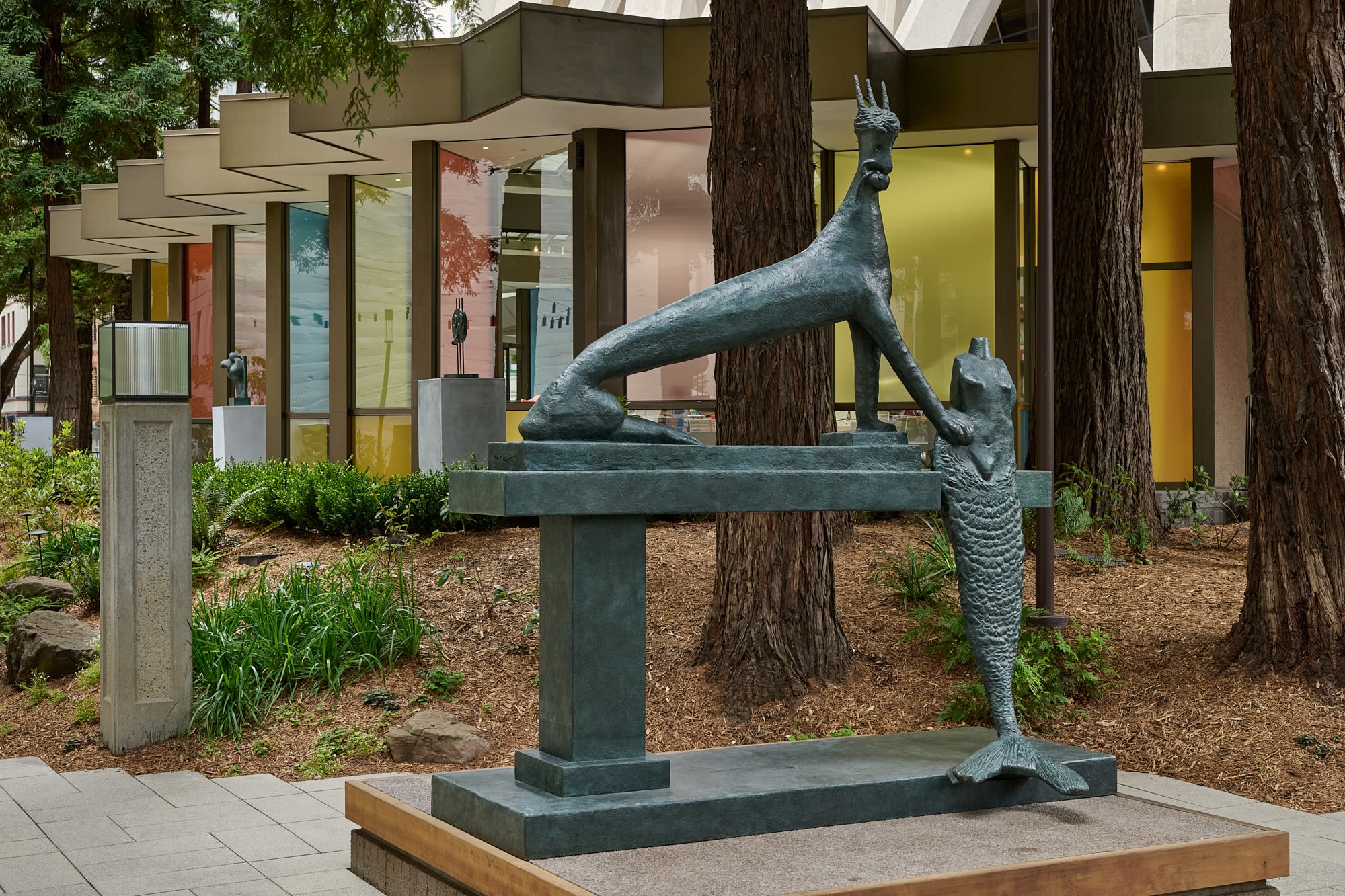
Max Ernst, "Sphinx et Sirène," cast in 1992. Bronze, 126 x 98 x 20 inches. © 2025 Artists Rights Society (ARS), New York / ADAGP, Paris. Photography by Glen Cheriton.
As for the mermaid, it is interesting to note the twin gestures between Ernst and Carrington, who at the time was painting the kitchen door inside the house with several mermaids and a large chimera. The figure of the mermaid is present in Carrington's library of youth, which was treasured by the artist-couple and is still preserved today. In this collection are texts such as Undine by Friedrich La Motte Fouqué and the tales of Hans Christian Andersen (including "The Mermaid"); this literature undoubtedly contributed to the omnipresence of this magical being in the imagination of both artists in those years.

Max Ernst, "Tête de sphinx," cast in 1990. Bronze, 33 1/4 x 17 1/2 x 10 1/2 inches. © 2025 Artists Rights Society (ARS), New York / ADAGP, Paris. Photography by Glen Cheriton.
The sculptural sphinx dominates the mermaid with its foreleg, resting on the female figure’s shoulder. In the lost original, both figures wore a similar crown made with a found object: a metal tillage fork. The standing mermaid, however, had already lost its head at the time the plasters for these bronzes were made, which is why it is presented headless today. It seems now to echo a late verse from a poem by Ernst: "Sons of the century / where do you have your tridents."
This use of the found object connects these works to both Ernst's very first sculptures, such as the assemblage Objet dad'art (1920), and with the following two pieces of the set: the masks that once crowned the lintels of two doors. These masks also stand as a testimony of works whose originals have disappeared. Evident in her photographs in Cahiers d'Art, Lee Miller knew how to connect these two masks with their context by featuring them with the stone architraves carved with the dates 1640 and 1735. Miller’s capture of these inscribed years along with the ethnologically inspired masks suggests the idea that Ernst added his own markers of time, which nevertheless contribute a timeless component to the storied dwelling. In Masque aux yeux rondes and Masque aux yeux invisibles (also known as Masque grimaçant or Masque à la langue) banal objects playfully make up two faces with open and closed eyes, the latter with a threatening tongue made from the tip of a scythe. These sculptures are in dialogue with his early “masks” with metallic elements, such as La Belle allemande (1934 - 1935), and later works created in Sedona, AZ, with Dorothea Tanning, like Moonmad (1944), which features a similar process of assemblage.
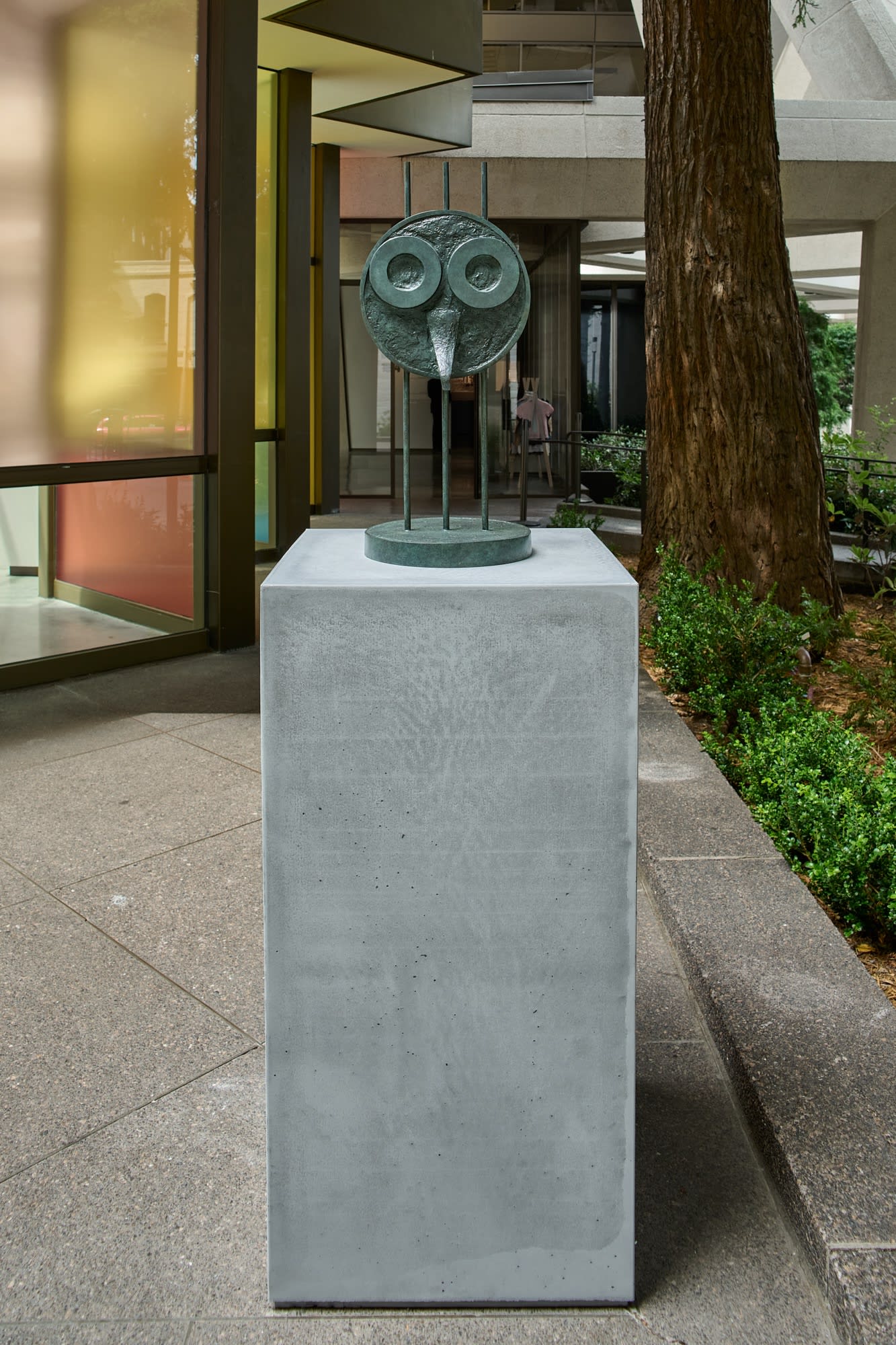
Max Ernst, "Masque aux yeux ronds," cast in 1991. Bronze, 28 1/2 x 12 1/4 x 12 1/2 inches. © 2025 Artists Rights Society (ARS), New York / ADAGP, Paris. Photography by Glen Cheriton.
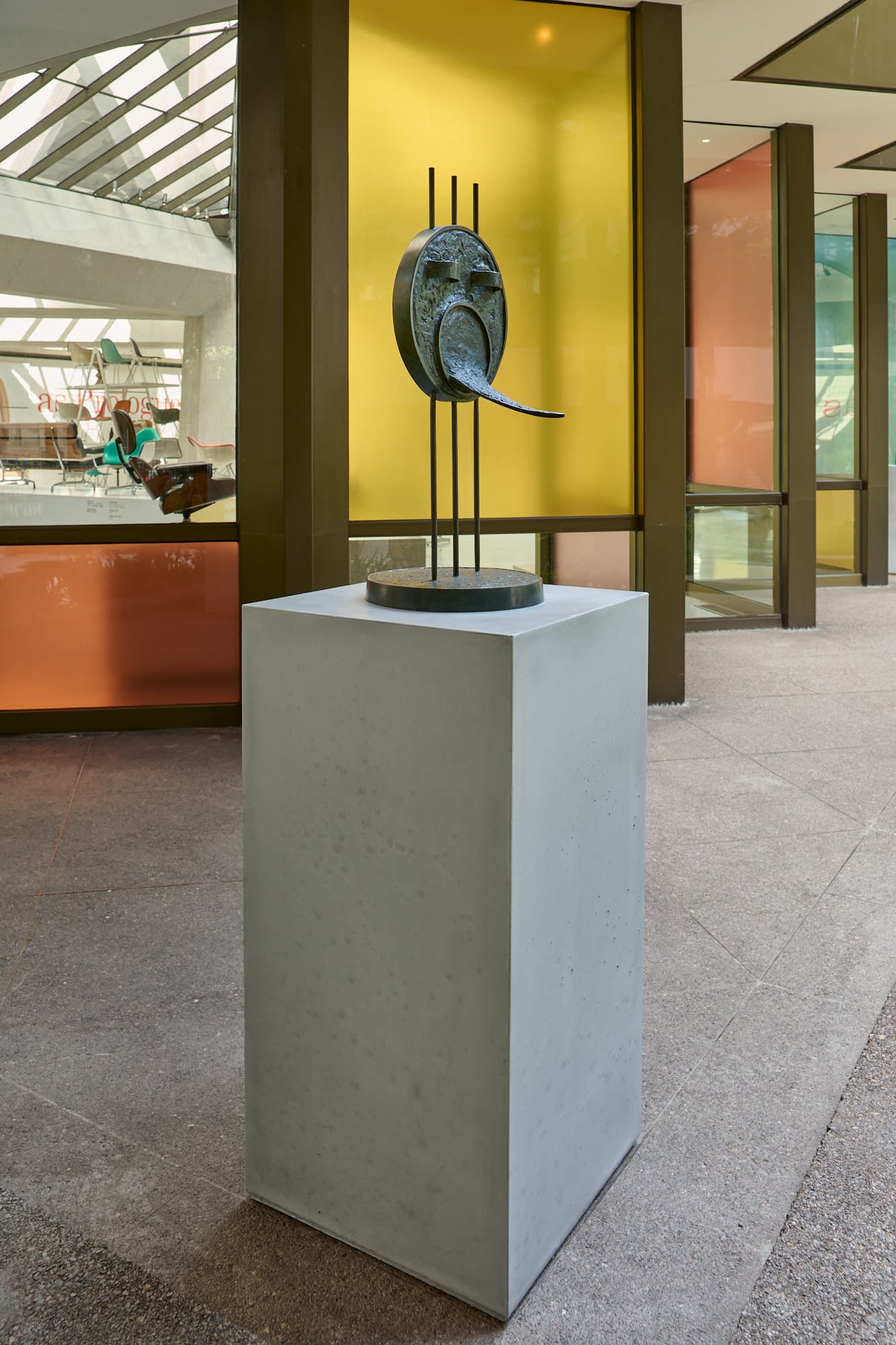
Max Ernst, "Masque aux yeux invisibles," cast in 1990. Bronze, 34 1/4 x 17 1/2 x 14 1/2 inches. © 2025 Artists Rights Society (ARS), New York / ADAGP, Paris. Photography by Glen Cheriton.
Crowning another of the openings in the main wall of the house is a window in which Ernst placed two figures, now completely gone, which form the composition L'Entrée des fantômes (also known as Deux bustes au poisson or Deux têtes au poisson). These two busts reiterate the same typology of two others already mentioned: the lower bust corresponds almost exactly with the head of Loplop ailé, while the upper one is very similar to the face of the sphinx that accompanies the mermaid in the monumental grouping in the garden. The latter bears a significant detail: the nose and mouth form the beak of a bird holding a fish, or perhaps a water snake or a newt. This detail of a creature triumphant over an animal with noxious connotations is repeated in the large fresco of the loggia mentioned above. It also insists on the protective, apotropaic qualities with which Ernst imbued his iconographic program; a way of dominating the landscape and its threats, a means to master nature.

Max Ernst, "L'Entrée des fantômes," cast in 1991. Bronze, 86 3/4 x 32 1/2 x 41 inches. © 2025 Artists Rights Society (ARS), New York / ADAGP, Paris. Photography by Glen Cheriton.
On the handrail of the staircase leading to the large entrance loggia, Ernst placed two more mermaids. Stretching their bodies, they accompany those ascending to the house. While only fragments of the lower mermaid still exist, the upper one has disappeared completely and survives only through this version in bronze.
Sirène ailée is also titled Les trois éléments because, to this amphibious creature—in which land and water are represented by its human-fish hybridity—Ernst adds two wings that make her a participant of a third element: air. The figure is a bold combination where the Nordic mermaid is joined with the siren of Greek mythology, represented as a monstrous winged woman. This mixture of references is also rooted in word play, since a mermaid and a siren are referred to by the same word in French: “sirène.” This winged siren or mermaid, in its composition based on units of articulated features, echoes earlier sculptures by Ernst, such as Oedipus, Habakuk or Les asperges de la lune (all made in 1934 from plaster and later cast in bronze), or the late La Plus belle (1967), all of which can be traced back to Ernst’s early collage The Hat Makes the Man (1920). This mermaid, therefore, represents a transition in a decades-long work process during which Ernst creates figures through the accumulation and interconnection of different pieces, a process that he once called the “game of anthropomorphic constructions.” A mark of the artist until his final years, this collage-like approach to sculpture allowed him to find his place in the complex field of modern sculpture.

Max Ernst, "Sirène ailée," cast in 1991. Bronze, 19 5/8 x 37 x 28 3/4 inches. © 2025 Artists Rights Society (ARS), New York / ADAGP, Paris. Photography by Glen Cheriton.
The loggia that unfolds upstairs is a large covered terrace that leads to the entrance of the house. It seems to be the place where Ernst used his concept of "sculpture-painting" with the greatest pleasure and ambition. The scenes presented in this section are created through an audacious combination of fresco painting, sculptural modeling, and found objects, which are all in dialogue with the pre-existing architecture. This set of bronzes brings together the three figures that decorate one of the walls. Génie de la cheminée uses a cavity in the wall to create an empty totemic character, a kind of stele or cippus like those that marked crossroads on Roman roads, often decorated with the androgynous figure of Mercury. Next to this character, two figures form a group: Masque de tête de chouette once crowned a female body with an owl's head protecting a fish-man, whose head is the one that forms the cast of La Nuit hurle. This composition is perhaps the one in which a key concept for both Ernst and Carrington is best presented: the androgyne as the ideal of alchemy. Androgyny reappears in a masterpiece painted by Ernst after losing Carrington. Titled The Robing of the Bride (1941), this picture is a perfect fusion of the tormented characters of the façade: the naked woman, the roaring lion echoed in the howling man, the bird, and the fish. This group also shows the four elements coming together in a single scene with two characters merged into one.
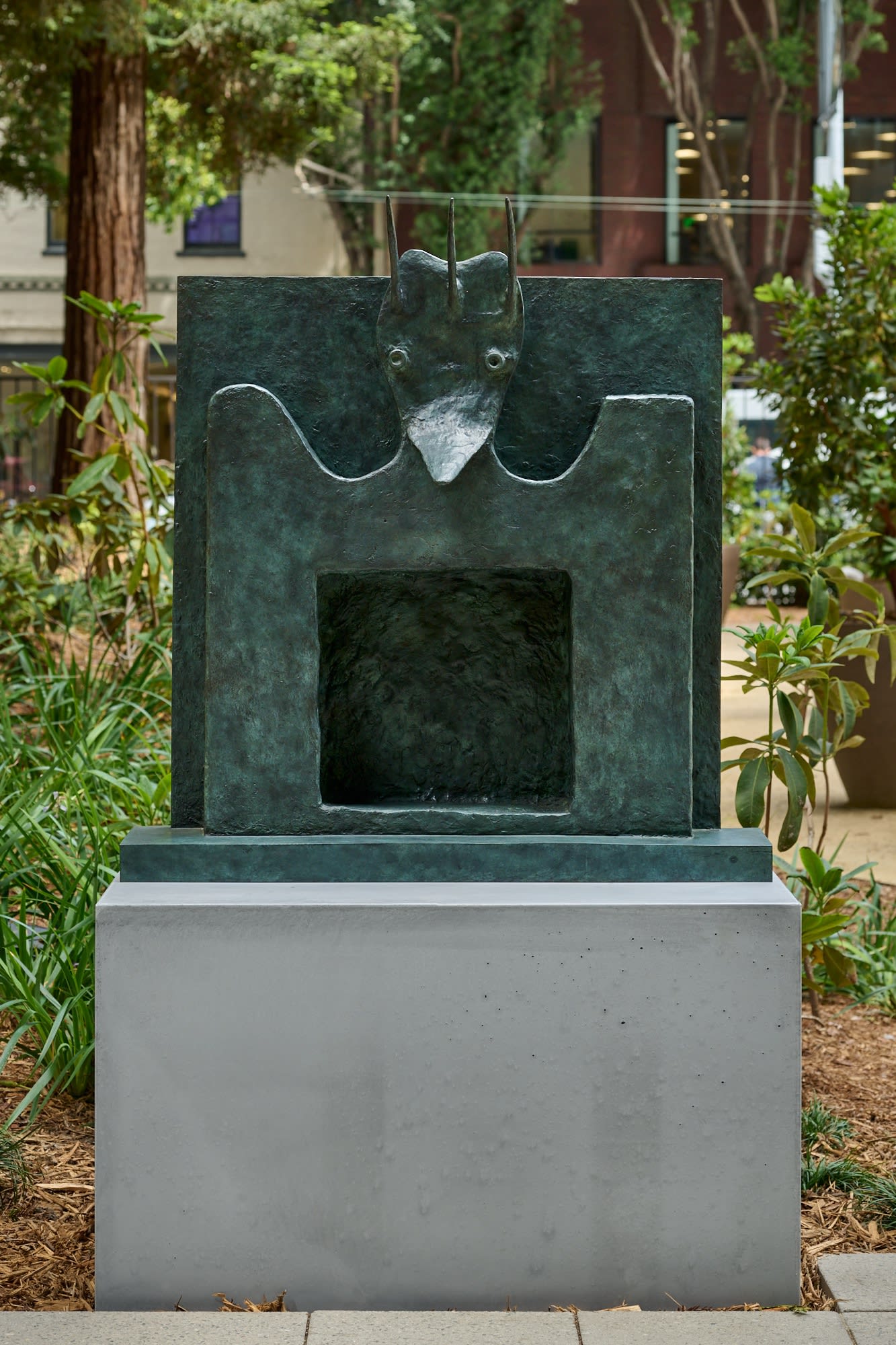
Max Ernst, "Génie de la cheminée," cast in 1991. Bronze, 36 1/2 x 13 3/4 x 14 1/2 inches. © 2025 Artists Rights Society (ARS), New York / ADAGP, Paris. Photography by Glen Cheriton.
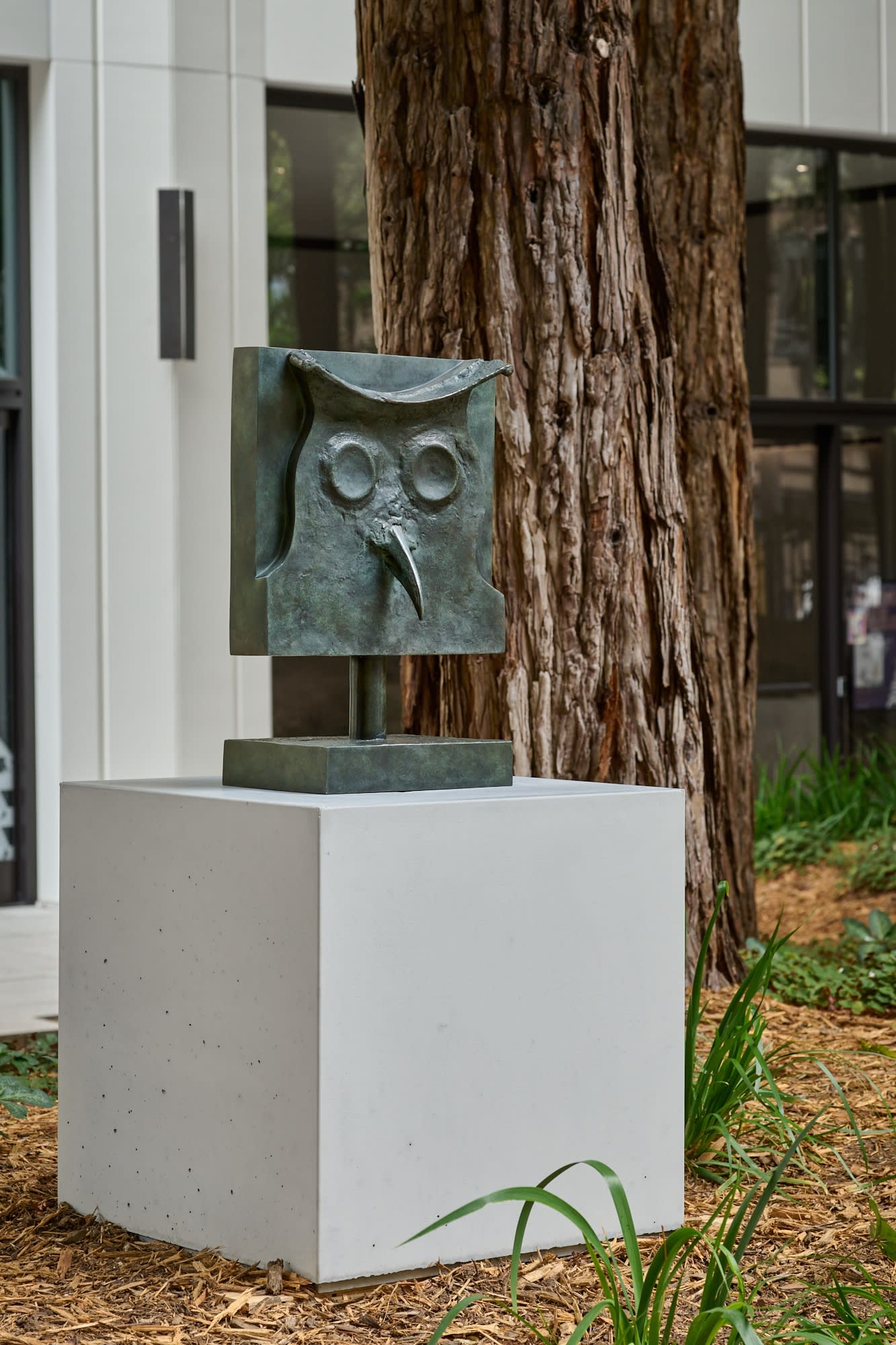
Max Ernst, "Masque de tête de chouette," cast in 1990. Bronze, 23 x 16 x 9 1/4 inches. © 2025 Artists Rights Society (ARS), New York / ADAGP, Paris. Photography by Glen Cheriton.

Max Ernst, "La Nuit hurle," cast in 1991. Bronze, 38 1/4 x 22 1/2 x 19 1/4 inches. © 2025 Artists Rights Society (ARS), New York / ADAGP, Paris. Photography by Glen Cheriton.
The last of the sculptures, La Femme à demi tête, is undoubtedly the most enigmatic of the group and the only piece conceived for the interior of the house, where it surprised visitors from a corner of the living room. Its alternative title, Personnage à la coquille, derives from the shell between its legs, which suggests an association with Venus. Yet another title, David and Goliath, has been used because the androgynous figure appears to stand above a giant’s head, though its singular eye suggests that it might be the cyclops Polyphemus of Homer’s Odyssey rather than the biblical giant. The sculpture connects to the rest of the iconographic program through its sympathetic, magic-like gesture which represents the suppression of evil or threatening forces.
It is also interesting to note two aspects of this piece: firstly, its original plaster is located not far from the cabinet painted by Carrington with a self-portrait featuring a horse's head; and, secondly, this type of female figure with a triangular head will be found, over the years, in Carrington's repertoire more than that of Ernst’s. Cat Woman (1951) is an example of a later work by Carrington where, in addition to that peculiar head, the position of the hands is almost identical to La Femme à demi tête. This is another example of the profound exchange between these two artists, whose creative boundaries during those brief years together in Saint-Martin-d'Ardèche are as blurred as those of their intimacy.
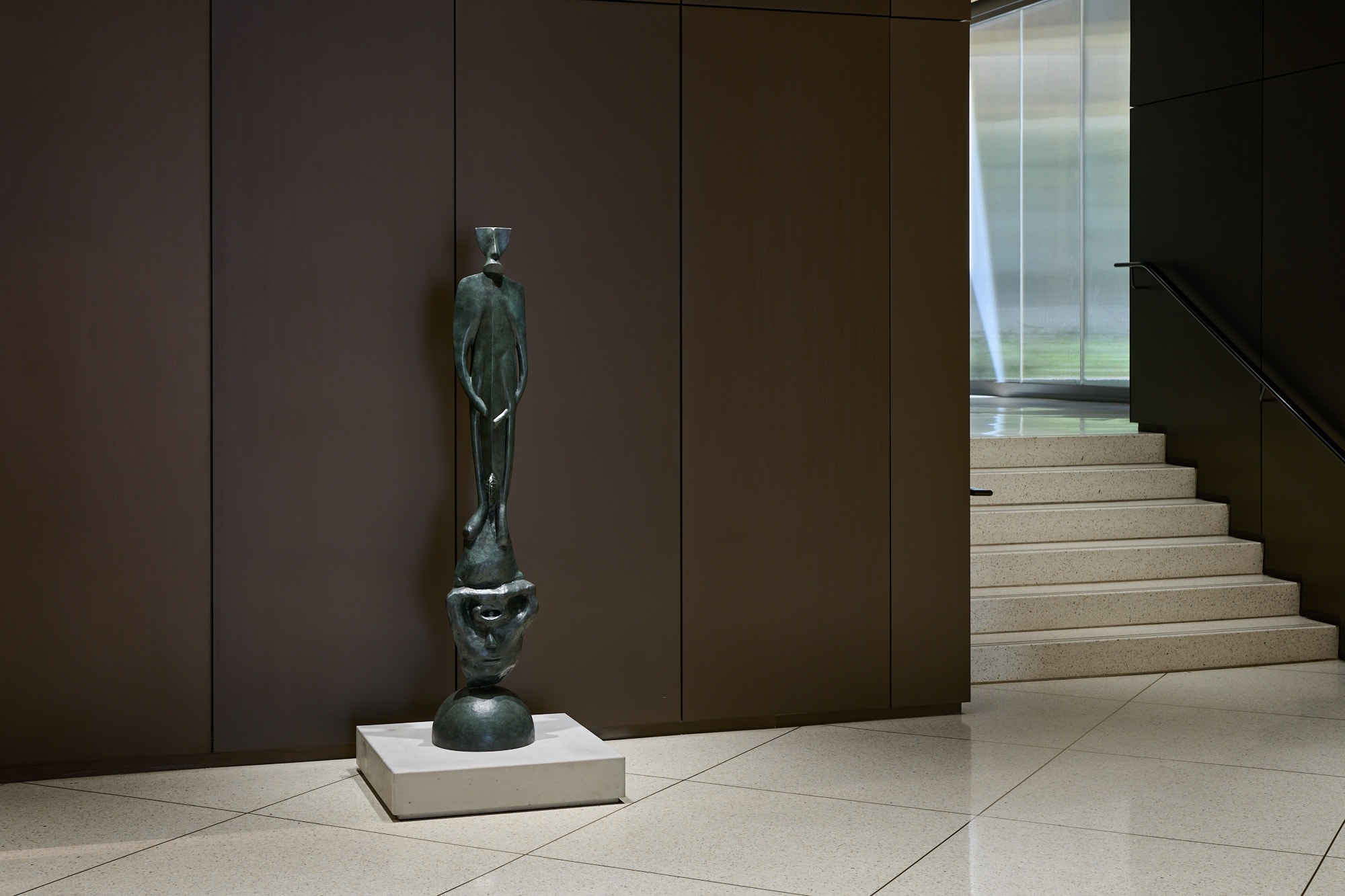
Max Ernst, "La Femme à demi-tête," cast in 1990. Bronze, 70 x 14 x 13 3/4 inches. © 2025 Artists Rights Society (ARS), New York / ADAGP, Paris. Photography by Glen Cheriton.
Conclusion: the prosthetic gods of Max Ernst
In her short novel Little Francis (1937), Leonora Carrington makes Uncle Ubriaco (Max Ernst’s alter ego) speak of a character who is, undoubtedly, himself:
They sat where they could see the river and the tall calcareous cliffs opposite. The rocks were shaped after a hundred different creatures. / 'I used to know a man who passed his whole life making the landscape into a zoo', said Uncle Ubriaco dreamily. / 'He worked for years making rocks into lions and tigers, cabinet ministers, centaurs, historical characters, etc. He was a charming fellow, but he worked too hard.
This artist is undoubtedly a reference to Ernst, but also to Ferdinand Cheval, the postman with no artistic background who created the awe-inspiring “Ideal Palace” not too far from Saint-Martin-d’Ardèche. This series of bronzes allows spectators to see how the Saint-Martin-d'Ardèche ensemble represents for Ernst a survey of his work up to that critical point of 1939. In his career there are other moments during which “catalogues” are silently made. For example, in the canvas Vox Angelica (1943), created during his exile in America, Ernst puts together the different modes of representation that have characterized his work since the 1920s.
This summative role of his sculptures from Saint-Martin-d'Ardèche is a sign of Ernst’s constant need to prove himself; they also anticipate the more important role that sculpture would take in his work after moving to the US. Moreover, they offer a clearer genealogy of Ernst’s work in domestic spaces: from the fresco in Éluard’s house in Eaubonne to the dwellings shared with Tanning in Sedona and Huismes, we can now consider this a typology of Ernst’s work where landscape, architecture, intimacy, spirituality, and artistic research are intertwined.
In all these cases, and especially in the protective figures of this house, one hears the echo of what Hal Foster calls “prosthetic gods.” Foster's book begins with a quotation from Sigmund Freud’s Civilization and its Discontents, of which a copy once belonging to Carrington is still preserved inside the house in Saint-Martin-d'Ardeche. This book seems to speak to us about these sculptures, which are spare parts of artworks that are no longer there; reminders, as are Ernst's works, of the incomplete, problematic, and hybrid quality of the human being. As Freud writes, "Man has, as it were, become a kind of prosthetic God. When he puts on all his auxiliary organs he is truly magnificent; but those organs have not grown onto him and they still give him much trouble at times."
SOURCES
Max Ernst: oeuvre sculpté: 1913-1961. Paris, Le Point Cardinal, 1961. [Cat.]
Max Ernst, Écritures. Paris, Gallimard, 1970.
Helmut R. Leppien and Werner Spies, Max Ernst: Oeuvre-Katalog, 1906-1963, the Complete Paintings, Drawings, Sculpture, Frottages and Collage (5 vols.). Köln, Dumont, Texas, Menil Foundation, 1975.
Max Ernst. Les sculptures de Saint-Martin d’Ardèche. Paris, Galerie Eric Touchaleaume, 1992. [Cat.]
Werner Spies (ed.), Max Ernst: Sculptures, Maisons, Paysages. Paris, Centre Georges Pompidou, 1998. [Cat.]
Werner Spies, Max Ernst. Vie et oeuvre. London, Thames and Hudson, 2006.
-

Roborant Review | Max Ernst, Transamerica Redwood Park, Gallery Wendi Norris
December 10, 2025By Sienna Freeman Upon crossing through the black wrought-iron gates of San Francisco's Transamerica Redwood Park, one encounters an unexpected urban sensorial cocktail: the freshness...Read more -

Art Bae | Like A Summer Thursday: An Alternative Art Loop
October 17, 2025By Janie Perez-Radler Slip back into the city and under the primordial trees at the recently renovated Transamerica Redwood Park. Twelve bronze sculptures by Max...Read more -

San Francisco Chronicle | Max Ernst sculptures bring surreal touch to Transamerica Pyramid
Max Ernst at Transamerica Pyramid Center August 1, 2025By Tony Bravo If you’re in the Jackson Square neighborhood, be sure to make a stop at the Transamerica Pyramid Center’s Redwood Park. Among the...Read more -
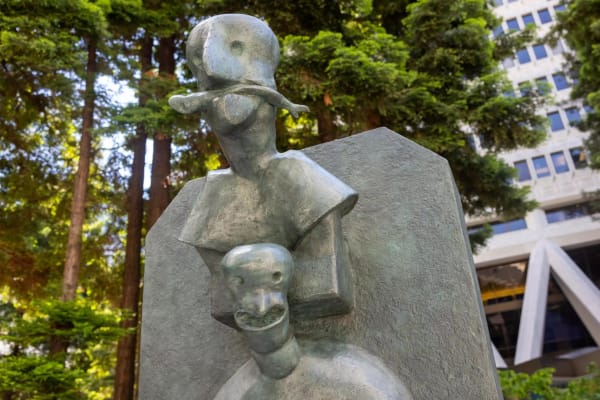
San Francisco Standard | Go Here Now: Transamerica Pyramid’s secret garden just got famed surrealist’s sculptures
Max Ernst at Transamerica Pyramid Center July 21, 2025By Sam Mondros Max Ernst’s fantastical bronze works take up residency in an oasis of redwoods in downtown San Francisco. Amid the steel canyons of...Read more


